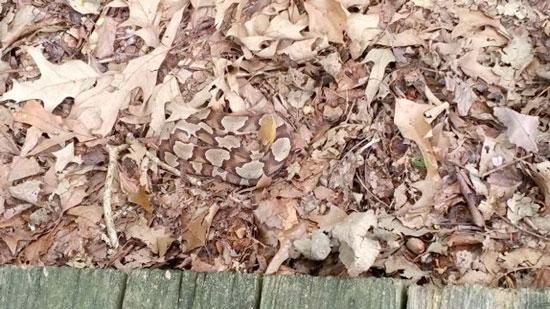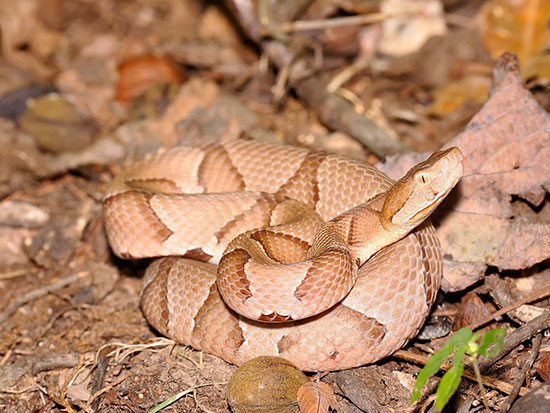 Find the snake? A copperhead's camouflage helps it avoid detection.Allison Davis never saw the snake. The Mountain Brook, Alabama, elementary school teacher was pulling weeds from a planter on her deck when she felt a sharp stab of pain in her left hand.
Find the snake? A copperhead's camouflage helps it avoid detection.Allison Davis never saw the snake. The Mountain Brook, Alabama, elementary school teacher was pulling weeds from a planter on her deck when she felt a sharp stab of pain in her left hand.
“I was pulling out some monkey grass, and suddenly there was a sharp pain on the little finger of my hand,” she recalled.
Her fingers began to swell, which soon spread to the top of her hand and her wrist. The hand was numb and it hurt. A lot.
“It felt like there were 100 bees stinging me,” Davis said. “Since I never saw a snake, I thought it was a spider bite.”
It was probably a copperhead snake, though, says University of Alabama at Birmingham emergency medicine physician Justin Arnold, D.O., who was on duty when Davis came into the UAB Highlands Hospital emergency department. Arnold is one of the few toxicologists in Alabama and director of the Regional Poison Control Center at Children’s of Alabama.
“It was obviously a snakebite,” said Arnold, an assistant professor in the Department of Emergency Medicine in the School of Medicine. “I could see the puncture wounds on her hand. Her arm was quite swollen, but she did not have any secondary issues, such as blood clotting, or systemic issues such as low blood pressure, rapid heart rate or difficulty breathing. That is consistent with copperhead bites, as their venom usually doesn’t produce those effects. Clotting and systemic effects are more common following bites from other vipers such as rattlesnakes or water moccasins.”
Arnold offers these tips if you or someone around you is bitten by a snake.
- Car keys or a cellphone are the most important first aid tools. Call 9-1-1 or go to a hospital emergency department immediately.
- Do not try to capture the snake — it could bite again. And do not bring the snake with you. Physicians do not need to see it, and taking a venomous — and angry — snake into an emergency department is a bad idea. However, take a photo if you can do so safely.
- Do not apply a tourniquet or use a venom extractor kit. Do not apply ice.
- Stay calm. On average, there are fewer than 10 fatal snakebites per year in the United States.
Arnold says to not be surprised if you do not immediately get antivenin. The first thing medical professionals will do is monitor your vital signs and observe the swelling around the bite.
“Most snakes are not venomous, and even those that are sometimes give dry bites, with no venom,” Arnold said. “We’ll watch a patient’s reaction and see if antivenin is warranted. In some cases, it’s not, even for venomous bites.”
 The range of the copperhead snake extends from New England to Texas.Which was the case for Allison Davis. By observing the swelling and noting none of the other deleterious effects sometimes caused by venom, Arnold determined that administering antivenin would not have been beneficial and might have led to unnecessary effects, such as an allergic reaction or serum sickness.
The range of the copperhead snake extends from New England to Texas.Which was the case for Allison Davis. By observing the swelling and noting none of the other deleterious effects sometimes caused by venom, Arnold determined that administering antivenin would not have been beneficial and might have led to unnecessary effects, such as an allergic reaction or serum sickness.
“Antivenin stops swelling, but it doesn’t reduce swelling,” he said. “It can also reverse clotting issues and help with systemic effects such as rapid heart rate or nausea. Mrs. Davis didn’t have any symptoms other than swelling and pain, and those had already stabilized, so antivenin would not have helped.”
Of course, the best way to deal with snakebite is to not get bitten in the first place. Ken Marion, Ph.D., a professor emeritus in the UAB Department of Biology, says the best defense is to be aware and alert.
“Many snakes, copperheads in particular, have excellent camouflage and are usually good at hiding,” Marion said. “Take a good look at your surroundings when outside. Watch where you step or place your hands.”
Marion says copperheads, whose range extends from Texas to Massachusetts, are often found in urban or suburban areas.
“Copperheads can make a home in small patches of woods or creeks even in developed areas,” he said. “Bigger, more showy snakes such as rattlesnakes have usually been eliminated in built-up areas, but copperheads are here.”
You can take some steps to reduce the likelihood that a snake will make itself at home in your backyard. Remove brush piles, stacks of firewood or construction debris; these make excellent snake dens.
Marion also recommends long pants and boots when in the woods, as they provide some protection against a sudden strike. He also says commercial snake repellents do not do much good.
“The anti-snake sprays you see in the home and garden store aren’t really effective in the long run,” he said. “The next rain will wash them away. Your best bet is to understand that you may be sharing your yard with a snake, and be vigilant. Copperheads are not usually aggressive, but will strike if you step on them or make contact with them.”
Davis is on the mend, but the swelling and numbness will last about a month.
“It feels like a Novocain shot where I was bit — still slightly numb, but I can use my left hand more now,” she said. “It is still bruised and very sensitive to touch.”
Davis is more careful when outdoors now, watching where she is walking. This is not something she wants to go through again.
“I’m ready for this incident to be over,” Davis said. “I’ve missed work and am still in some discomfort. I’m just so fortunate that Dr. Arnold is such an expert in treating snakebite. He was outstanding, and I strongly recommend that people go immediately to an emergency department if ever bitten by a snake.”